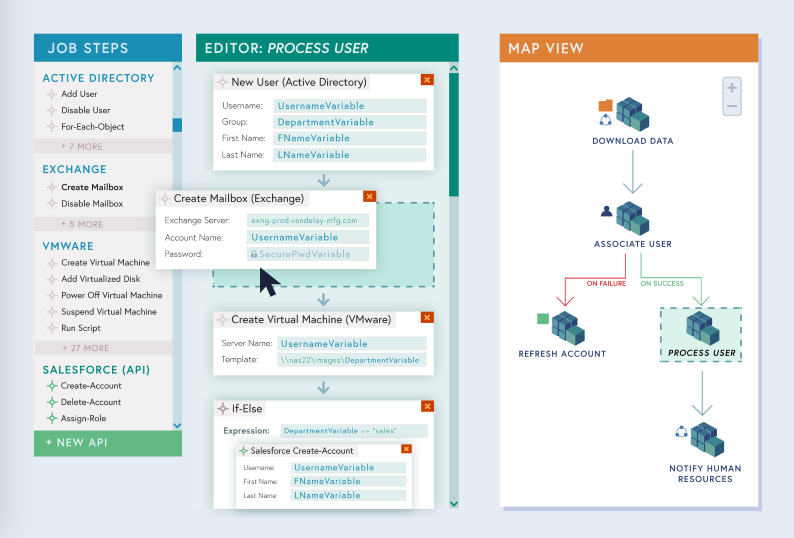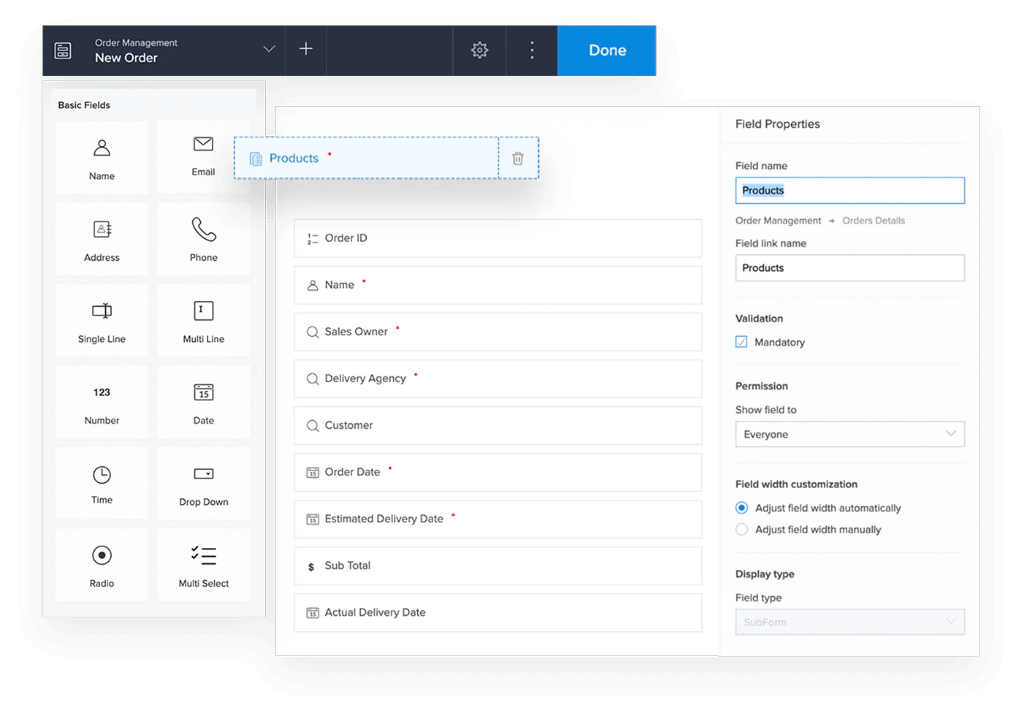Low-code application development offers a variety of advantages, specifically in terms of integration. This is crucial for creating applications that can seamlessly connect to systems and other services. Here are the key benefits: Pre-built Connectors and APIs
A wide range of connectors available Low-code platforms include a large collection of pre-built connectors to common enterprise systems (e.g. ERP, CRM databases cloud services, etc.). This makes it easier for integration with these systems.
API Integration - Many low-code platforms have built-in API integration, allowing developers easy access to other data sources or external services.
Easy of use:
Drag-and Drop Integration: Many integration tasks are performed with drag-and-drop interfaces. This allows both developers and nondevelopers to create complex integrations with little or no programming.
Visual Workflow Builders: These visual tools are used for designing workflows, data flow and integrations. They help with understanding and setting up workflows more easily.
Standardized Integration Methods:
SOAP and Restful Service: Supporting the standard web service protocols such as SOAP or REST allows you to integrate external systems and applications.
OData Standards and other Standards Support for standards, such as OData permits easy access to data and its manipulation across multiple platforms and apps.
Real-Time Data Synchronization:
Real-Time Integrations: Low-code platforms are capable of handling real-time data sync between systems and applications. This ensures that information is current and synchronized across the company.
Event-Driven Architect: Some platforms have event-driven structures, which allow applications to react instantly to any event. This is important for interactive and dynamic applications.
Legacy System Integration:
Low-code platforms provide many tools for integrating with legacy systems. They allow organizations to modernize IT without having to overhaul their existing systems.
Data Migration Tools Data Migration Tools aid in the transfer of data from old systems to the latest applications developed on low-code platforms.
Third-Party Integration of Service:
Cloud Services Integration: The seamless integration of cloud services, such as AWS Azure, Google Cloud makes it easy to deploy and scaling up of applications.
Business Applications Integration: Low-code platforms are able to be integrated with other business applications like Salesforce, SAP and Microsoft Dynamics. This allows for a seamless workflow between business tasks.
Simple Data Management:
Unified Data Models: Some platforms that use low-code provide unified data modeling that makes data integration and management across different platforms.
Data connectors: Data connectors that are preconfigured to allow easy access and modification to data from a variety of sources.
Security and compliance
Secure Integrations: Low-code systems ensure that integrations comply with security protocols and standards, helping to secure data both during transport and in storage.
These platforms are often packed with features to in ensuring compliance (e.g. HIPAA, GDPR) and provide assurance to companies that handle sensitive data.
Extensibility:
Low-code platforms allow for the creation of custom scripts and codes to meet more complex integration requirements. This flexibility is available without compromising ease of use.
Plug-in Ecosystem : An ecosystem of plugins and extensions that allows integration to be enhanced through allowing users to add new functionality as required.
Overall, the integration capabilities of low-code applications development platforms make them a powerful instrument for developing interconnected, efficient, and scalable applications. They can speed up the process of connecting disparate systems, and increase the flow of data. Companies can benefit from existing technology and implement new ones while maintaining a unified IT environment. See the top rated consultant for Low-code Platform for application development for site info including rapid action development, app dev platform, app development platform, rad development, rapid applications, low code platforms, push notifications android, low code platforms, azure sql server, application modernization and more.

Advantages Of Low-Code Application Development In Terms Of Cost-Effectiveness
Low-code app development offers many advantages, including cost-effectiveness. It is a popular alternative for companies looking to reduce development costs without sacrificing quality. Here are a few of the key advantages.
Less Coding Needed: Low-code platform makes it less necessary to write lengthy manual coding. This reduces time and effort of developers when developing their applications. This leads to lower costs of labor.
We require less developer resources. Low-code development requires less time and is easier. This means that fewer developers are required. This can drastically reduce costs for hiring and staffing.
Speedier Time to Market
Accelerated Development Cycle: The visual tools for development and the pre-built parts offered by low-code platforms facilitate rapid development of applications, which allows companies to get their products on market quicker. This can lead to faster revenue generation and better position in the marketplace.
Rapid prototyping. Businesses can rapidly test and build prototypes. This helps reduce time in the development process and permits quicker iterations based on feedback from users.
Reduce the cost of maintenance
Simplified Maintenance: Applications built on low-code platforms tend to be simpler to maintain because of their standardized components and modular architecture. This reduces the cost of maintenance and support.
Automated Updates. Many low-code platforms manage updates and patch automatically. Applications remain safe without the need for extensive manual input.
Efficient Resource Utilization:
Platform contributions that are low-code let businesses as well as other non-developers to participate in the creation process. This decentralization of development enables companies to benefit from the talents of a wider variety of employees, reducing dependency on high-paying developers.
Optimized Use Of IT Resources IT teams can focus on strategic projects instead of being stymied by routine development tasks, increasing efficiency and productivity overall.
Models of pricing that are scalable:
Subscription-Based Pricing: Many low-code platforms offer flexible, subscription-based pricing plans that grow according to use. This lets businesses match their spending to their needs and grow.
Pay-as-you-go options Certain platforms allow businesses to pay only for what they use. This is particularly beneficial for startups or small companies with limited funds.
Reduce the costs of third-party software
Low-code platforms are built-in with functions and integrations, which could reduce the cost of subscriptions to software and licensing.
Pre-Built Intergrations: The ability to use pre-built integrations and pre-built integrations for popular systems and services reduces the requirement for custom development and can save time and money.
Better ROI:
Increased ROI: Businesses will gain a greater return on investment from their applications by combining rapid development, less expensive, and faster times to market.
Improved agility: Companies can respond quickly to changes in the market or to customer demands and this allows businesses to stay relevant and take advantage of new opportunities.
The cost of training is cheaper:
User-Friendly Interfaces: The intuitive user-friendly interfaces on low-code platforms can reduce the learning curve for novice users, and reduce the requirement for lengthy training programs.
Accessible Resources. Many low-code platforms provide extensive training materials, tutorials, as well community support. They make it less necessary for formal education, which can be costly.
Collaboration can be streamlined.
Enhanced Collaboration Tool The built-in collaboration tool facilitates better collaboration and communication between team members. This results in faster development processes and also reduces the cost of projects.
Unified Development Environment. An unified development platform helps reduce costs and streamline workflows by simplifying the management of multiple tools.
In the end, the value of developing low-code applications stems in its ability to lower development and maintenance costs and speed up time to market, maximize the utilization of resources, and offer flexible pricing models. This combination of factors offers businesses substantial financial benefits and makes low-code an appealing option for businesses looking to increase their development budgets while still creating strong and adaptable applications. Take a look at the best her explanation about Legacy application modernization with Low-code for website tips including cross platform mobile dev, application modernization, app modernization, rad development, rad development, jdbc server, mobile development platforms, build a docker container, azure sql, develop mobile application and more.

Benefits Of Low-Code Application Development With Respect To Limitations And Customization
Low-code development provides an unbiased approach to dealing with limitations, while also allowing for the possibility of personalization. Here are a few of the main advantages.
: .
Low-code development platforms are easier to use since they offer pre-built components, templates, as well as other tools. They also facilitate quicker deployment of even complex applications.
Guided Workflows A lot of platforms provide workflows and wizards that help developers through complex processes. This reduces the possibility of error while also ensuring uniformity.
Scalability Solutions:
Built-in Scalability: Low-code platforms often include features that support the development of scalable architectures, which allows applications to handle increased loads without significant redevelopment.
Performance Monitoring: The integrated tools for monitoring performance and optimization help ensure that applications remain efficient when they grow.
Security and Compliance
Security features integrated into low-code platforms include security measures like encryption, role-based control of access and automated compliance monitoring, which address common security issues.
Platforms are constantly updating their security protocols to ensure compliance with regulatory requirements. This helps keep platforms safe from new threats.
Features of Customization:
Extensibility:
Low-code platforms allow custom code Platforms that allow the integration and use of customized code.
Custom Plugins and Moduls: Developers may develop custom plug-ins and modules that have specific features that are tailored to the specific requirements of a business.
APIs and Integration:
API Support - The extensive support of APIs facilitates seamless integration with other systems and services and allows for complete modification.
Third-Party Applications Lowcode platforms are usually pre-built with connectors for third-party apps, making it easier to integrate them and modify the app.
Flexible UI/UX Design:
Customizable User Interfaces: Developers are able to alter and design user interfaces that are in line with branding and usability specifications, creating a tailored user's experience.
Responsive Design: Built-in responsive design capabilities mean that apps can be tailored to fit different screens and devices.
Making Business Logic more flexible is simple:
Visual Workflow Builds Visual tools that permit the modification of workflows as well as business rules and to design complex, tailored processes.
Platforms can be equipped with conditional Logic that allows the development of custom scripts to address specific scenarios and business rules.
Data Management
Custom Data Models: Developers may define custom data models to fit specific needs of the application and ensure that data handling is customized to the business needs.
Advanced Data processing Integration and advanced data handling tools allow for customisation of the data analysis process and use within the application.
Customisation and balancing limits:
Frameworks & Standards
Best Practices: Low-code platform encourages adherence to standards and industry best practices. This is helpful in maintaining high quality secure, scalable, and scalable applications.
Governance Frameworks Governance Frameworks: Integrated governance frameworks make sure that customizations don't affect the integrity, conformity, or security of the application.
Iterative design and feedback:
Rapid Prototyping. Developers can develop and improve applications based on the feedback of users.
Low-code platforms are designed to support continual enhancement. This allows for customizations and enhancements as business requirements evolve.
User Empowerment
Helping Citizen developers become empowered: The Low-Code interfaces that are intuitive allow non-developers to modify the application. This can increase the number of users who are able to modify and improve applications.
Training and Support Many platforms offer extensive training and support resources to assist users with efficient modifications without compromising the stability of the application or its performance.
Overall, Low-code application creation offers a framework that is sturdy and adaptable enough to handle limitations while still allowing for plenty of customisation. This balance allows companies to develop and maintain applications that are efficient, adapted for their specific needs and adhere to high standards in terms of security, quality and scaleability.
